Comprehensive Essay: Hospital Acquired Infections in Healthcare
VerifiedAdded on 2021/08/03
|8
|1593
|120
Essay
AI Summary
This essay critically analyzes hospital acquired infections (HAIs), also known as nosocomial infections, which pose a significant public health problem. The essay explores the causes, risk factors, including patient conditions, virulence of microorganisms, and factors related to hospitalization such as invasive procedures and hand hygiene. It highlights the importance of hand washing, pre-existing illnesses, antibiotic use, and staffing levels in the transmission of infections. Prevention strategies, including hand sanitization, visitor rules, cleaning standards, and proper antibiotic use, are discussed. The essay emphasizes the need for a multifaceted approach involving healthcare professionals, patients, and their families to minimize the impact of HAIs on patient health and the reputation of healthcare establishments. It concludes by underscoring the urgent need to understand the causes and adopt effective prevention practices to combat hospital acquired infections.
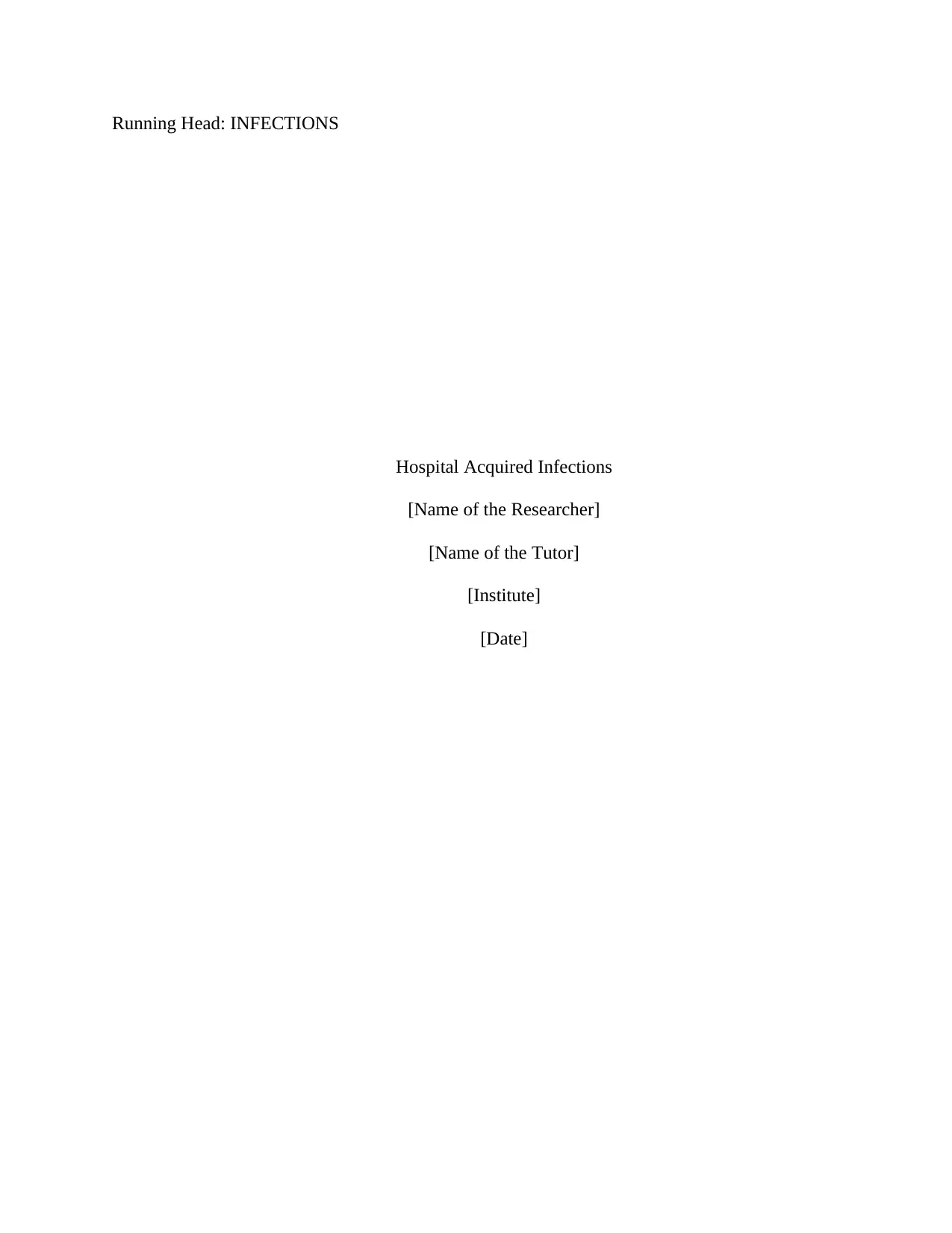
Running Head: INFECTIONS
Hospital Acquired Infections
[Name of the Researcher]
[Name of the Tutor]
[Institute]
[Date]
Hospital Acquired Infections
[Name of the Researcher]
[Name of the Tutor]
[Institute]
[Date]
Paraphrase This Document
Need a fresh take? Get an instant paraphrase of this document with our AI Paraphraser

Infections 2
Table of Contents
Table of Contents
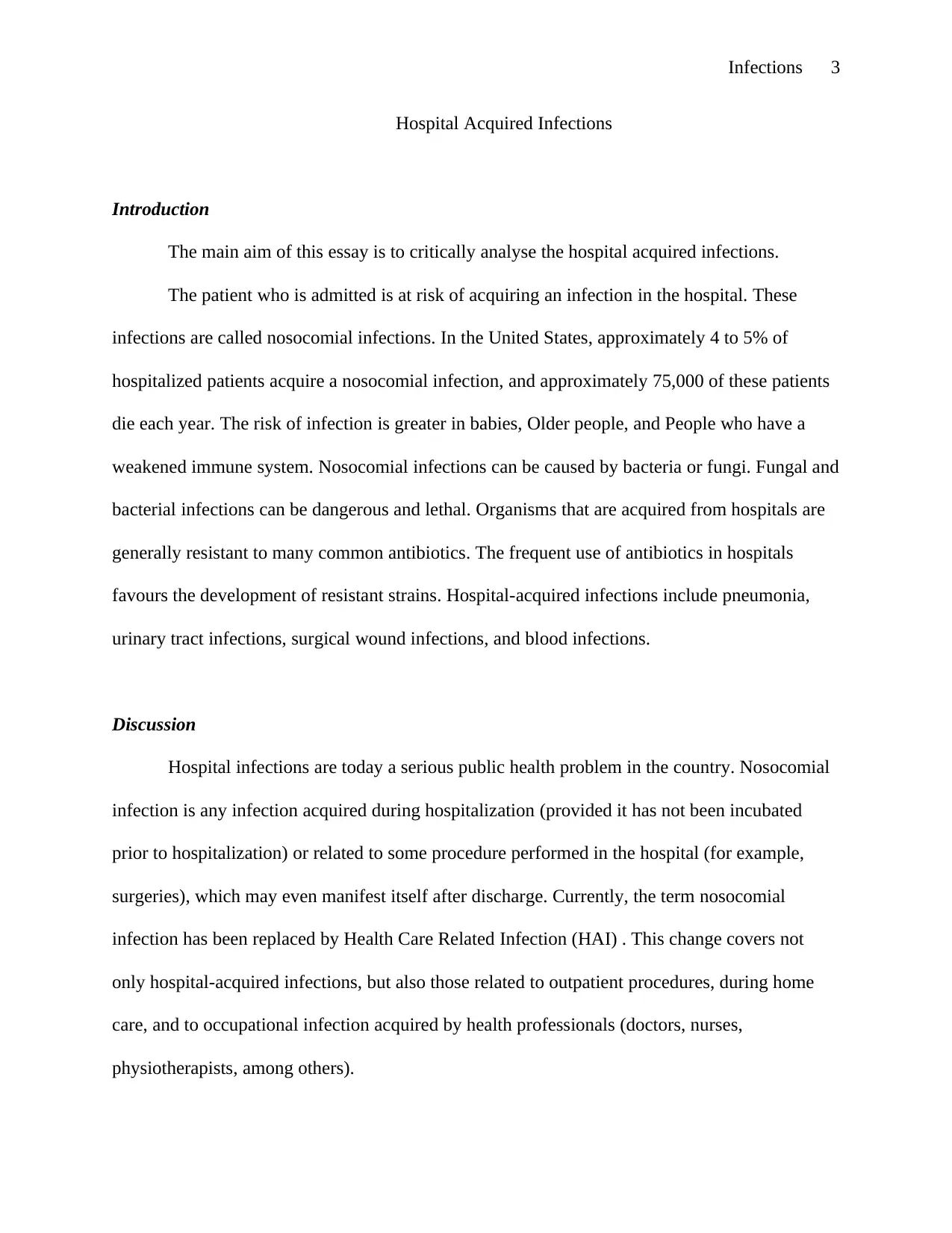
Infections 3
Hospital Acquired Infections
Introduction
The main aim of this essay is to critically analyse the hospital acquired infections.
The patient who is admitted is at risk of acquiring an infection in the hospital. These
infections are called nosocomial infections. In the United States, approximately 4 to 5% of
hospitalized patients acquire a nosocomial infection, and approximately 75,000 of these patients
die each year. The risk of infection is greater in babies, Older people, and People who have a
weakened immune system. Nosocomial infections can be caused by bacteria or fungi. Fungal and
bacterial infections can be dangerous and lethal. Organisms that are acquired from hospitals are
generally resistant to many common antibiotics. The frequent use of antibiotics in hospitals
favours the development of resistant strains. Hospital-acquired infections include pneumonia,
urinary tract infections, surgical wound infections, and blood infections.
Discussion
Hospital infections are today a serious public health problem in the country. Nosocomial
infection is any infection acquired during hospitalization (provided it has not been incubated
prior to hospitalization) or related to some procedure performed in the hospital (for example,
surgeries), which may even manifest itself after discharge. Currently, the term nosocomial
infection has been replaced by Health Care Related Infection (HAI) . This change covers not
only hospital-acquired infections, but also those related to outpatient procedures, during home
care, and to occupational infection acquired by health professionals (doctors, nurses,
physiotherapists, among others).
Hospital Acquired Infections
Introduction
The main aim of this essay is to critically analyse the hospital acquired infections.
The patient who is admitted is at risk of acquiring an infection in the hospital. These
infections are called nosocomial infections. In the United States, approximately 4 to 5% of
hospitalized patients acquire a nosocomial infection, and approximately 75,000 of these patients
die each year. The risk of infection is greater in babies, Older people, and People who have a
weakened immune system. Nosocomial infections can be caused by bacteria or fungi. Fungal and
bacterial infections can be dangerous and lethal. Organisms that are acquired from hospitals are
generally resistant to many common antibiotics. The frequent use of antibiotics in hospitals
favours the development of resistant strains. Hospital-acquired infections include pneumonia,
urinary tract infections, surgical wound infections, and blood infections.
Discussion
Hospital infections are today a serious public health problem in the country. Nosocomial
infection is any infection acquired during hospitalization (provided it has not been incubated
prior to hospitalization) or related to some procedure performed in the hospital (for example,
surgeries), which may even manifest itself after discharge. Currently, the term nosocomial
infection has been replaced by Health Care Related Infection (HAI) . This change covers not
only hospital-acquired infections, but also those related to outpatient procedures, during home
care, and to occupational infection acquired by health professionals (doctors, nurses,
physiotherapists, among others).
⊘ This is a preview!⊘
Do you want full access?
Subscribe today to unlock all pages.

Trusted by 1+ million students worldwide
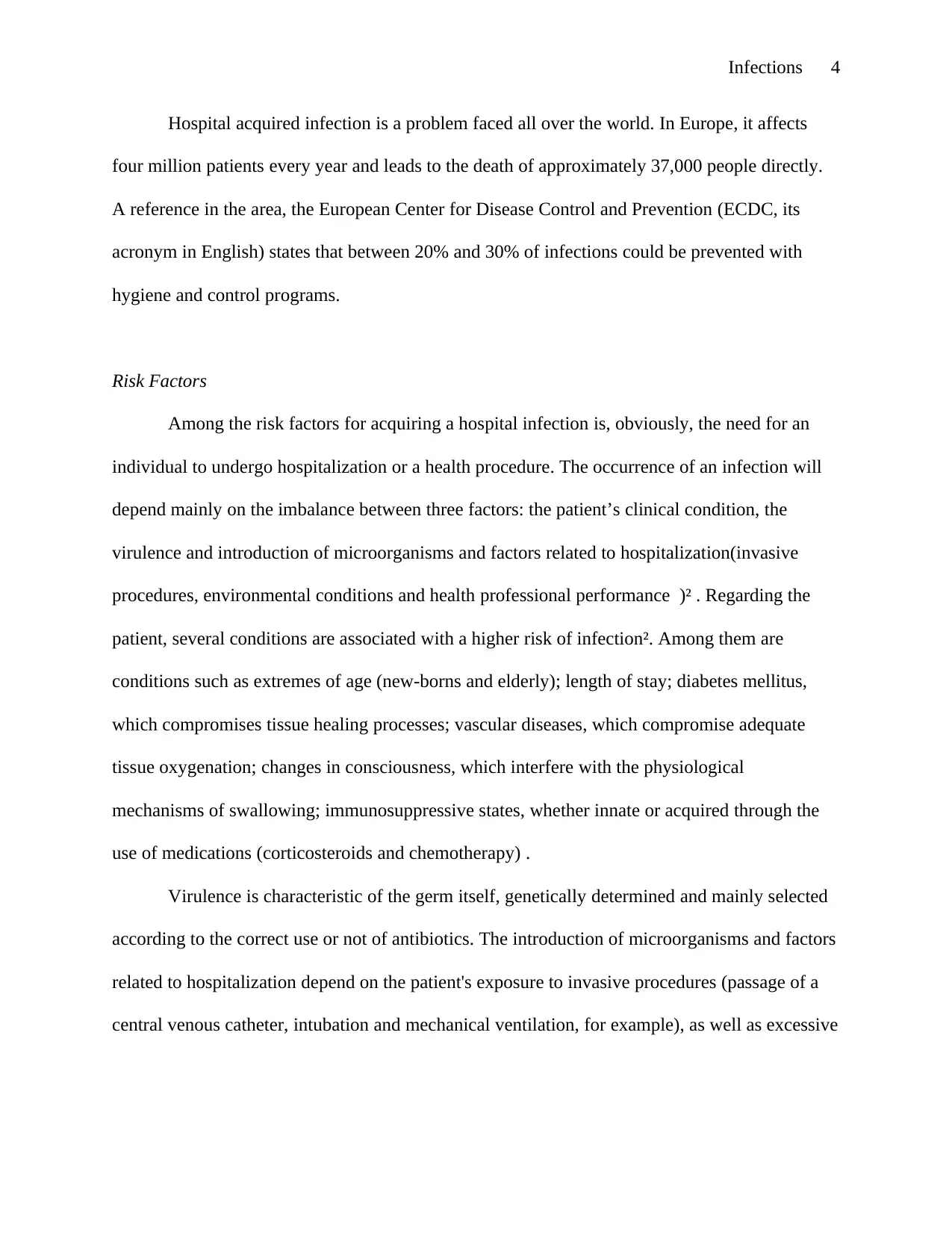
Infections 4
Hospital acquired infection is a problem faced all over the world. In Europe, it affects
four million patients every year and leads to the death of approximately 37,000 people directly.
A reference in the area, the European Center for Disease Control and Prevention (ECDC, its
acronym in English) states that between 20% and 30% of infections could be prevented with
hygiene and control programs.
Risk Factors
Among the risk factors for acquiring a hospital infection is, obviously, the need for an
individual to undergo hospitalization or a health procedure. The occurrence of an infection will
depend mainly on the imbalance between three factors: the patient’s clinical condition, the
virulence and introduction of microorganisms and factors related to hospitalization(invasive
procedures, environmental conditions and health professional performance )² . Regarding the
patient, several conditions are associated with a higher risk of infection². Among them are
conditions such as extremes of age (new-borns and elderly); length of stay; diabetes mellitus,
which compromises tissue healing processes; vascular diseases, which compromise adequate
tissue oxygenation; changes in consciousness, which interfere with the physiological
mechanisms of swallowing; immunosuppressive states, whether innate or acquired through the
use of medications (corticosteroids and chemotherapy) .
Virulence is characteristic of the germ itself, genetically determined and mainly selected
according to the correct use or not of antibiotics. The introduction of microorganisms and factors
related to hospitalization depend on the patient's exposure to invasive procedures (passage of a
central venous catheter, intubation and mechanical ventilation, for example), as well as excessive
Hospital acquired infection is a problem faced all over the world. In Europe, it affects
four million patients every year and leads to the death of approximately 37,000 people directly.
A reference in the area, the European Center for Disease Control and Prevention (ECDC, its
acronym in English) states that between 20% and 30% of infections could be prevented with
hygiene and control programs.
Risk Factors
Among the risk factors for acquiring a hospital infection is, obviously, the need for an
individual to undergo hospitalization or a health procedure. The occurrence of an infection will
depend mainly on the imbalance between three factors: the patient’s clinical condition, the
virulence and introduction of microorganisms and factors related to hospitalization(invasive
procedures, environmental conditions and health professional performance )² . Regarding the
patient, several conditions are associated with a higher risk of infection². Among them are
conditions such as extremes of age (new-borns and elderly); length of stay; diabetes mellitus,
which compromises tissue healing processes; vascular diseases, which compromise adequate
tissue oxygenation; changes in consciousness, which interfere with the physiological
mechanisms of swallowing; immunosuppressive states, whether innate or acquired through the
use of medications (corticosteroids and chemotherapy) .
Virulence is characteristic of the germ itself, genetically determined and mainly selected
according to the correct use or not of antibiotics. The introduction of microorganisms and factors
related to hospitalization depend on the patient's exposure to invasive procedures (passage of a
central venous catheter, intubation and mechanical ventilation, for example), as well as excessive
Paraphrase This Document
Need a fresh take? Get an instant paraphrase of this document with our AI Paraphraser
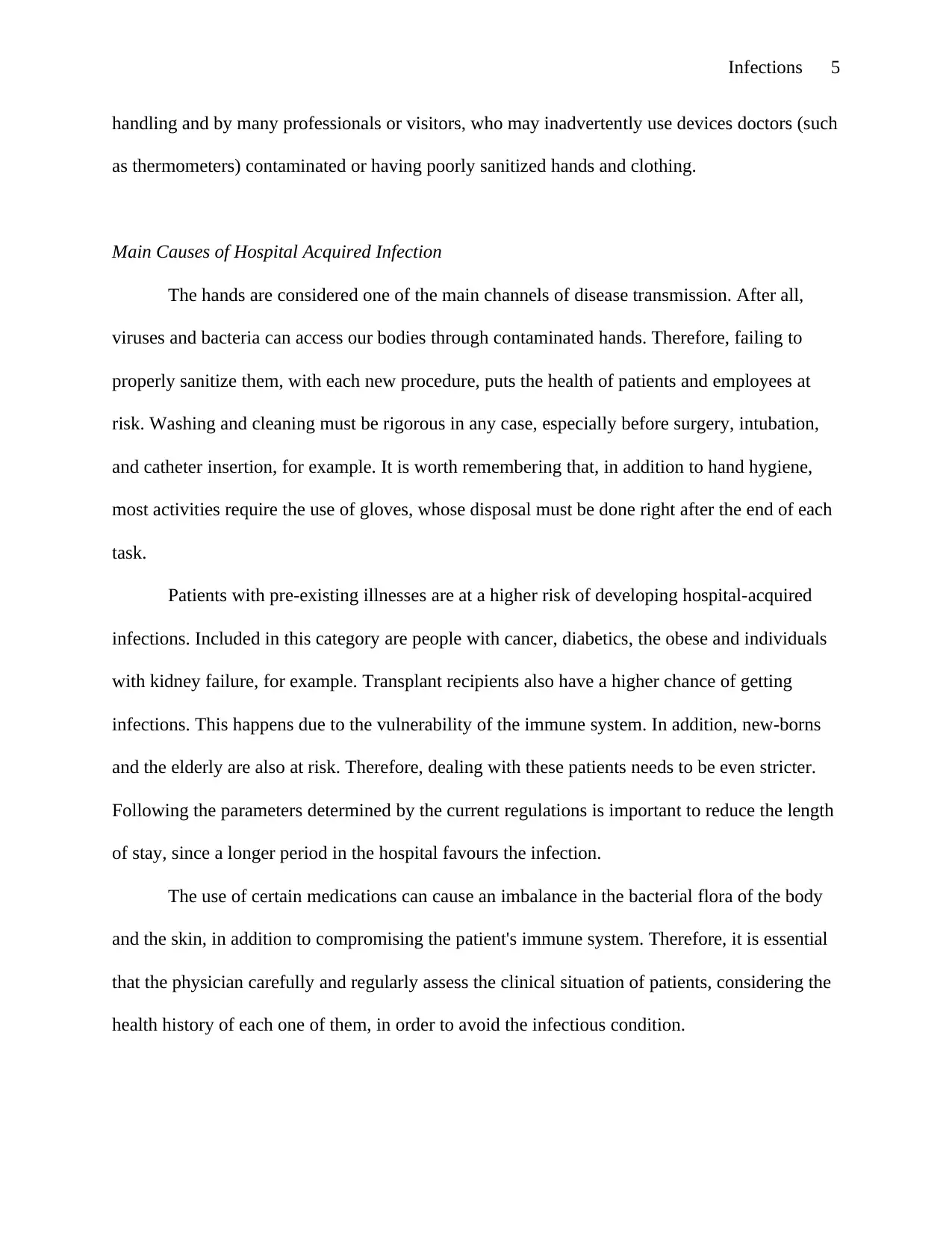
Infections 5
handling and by many professionals or visitors, who may inadvertently use devices doctors (such
as thermometers) contaminated or having poorly sanitized hands and clothing.
Main Causes of Hospital Acquired Infection
The hands are considered one of the main channels of disease transmission. After all,
viruses and bacteria can access our bodies through contaminated hands. Therefore, failing to
properly sanitize them, with each new procedure, puts the health of patients and employees at
risk. Washing and cleaning must be rigorous in any case, especially before surgery, intubation,
and catheter insertion, for example. It is worth remembering that, in addition to hand hygiene,
most activities require the use of gloves, whose disposal must be done right after the end of each
task.
Patients with pre-existing illnesses are at a higher risk of developing hospital-acquired
infections. Included in this category are people with cancer, diabetics, the obese and individuals
with kidney failure, for example. Transplant recipients also have a higher chance of getting
infections. This happens due to the vulnerability of the immune system. In addition, new-borns
and the elderly are also at risk. Therefore, dealing with these patients needs to be even stricter.
Following the parameters determined by the current regulations is important to reduce the length
of stay, since a longer period in the hospital favours the infection.
The use of certain medications can cause an imbalance in the bacterial flora of the body
and the skin, in addition to compromising the patient's immune system. Therefore, it is essential
that the physician carefully and regularly assess the clinical situation of patients, considering the
health history of each one of them, in order to avoid the infectious condition.
handling and by many professionals or visitors, who may inadvertently use devices doctors (such
as thermometers) contaminated or having poorly sanitized hands and clothing.
Main Causes of Hospital Acquired Infection
The hands are considered one of the main channels of disease transmission. After all,
viruses and bacteria can access our bodies through contaminated hands. Therefore, failing to
properly sanitize them, with each new procedure, puts the health of patients and employees at
risk. Washing and cleaning must be rigorous in any case, especially before surgery, intubation,
and catheter insertion, for example. It is worth remembering that, in addition to hand hygiene,
most activities require the use of gloves, whose disposal must be done right after the end of each
task.
Patients with pre-existing illnesses are at a higher risk of developing hospital-acquired
infections. Included in this category are people with cancer, diabetics, the obese and individuals
with kidney failure, for example. Transplant recipients also have a higher chance of getting
infections. This happens due to the vulnerability of the immune system. In addition, new-borns
and the elderly are also at risk. Therefore, dealing with these patients needs to be even stricter.
Following the parameters determined by the current regulations is important to reduce the length
of stay, since a longer period in the hospital favours the infection.
The use of certain medications can cause an imbalance in the bacterial flora of the body
and the skin, in addition to compromising the patient's immune system. Therefore, it is essential
that the physician carefully and regularly assess the clinical situation of patients, considering the
health history of each one of them, in order to avoid the infectious condition.
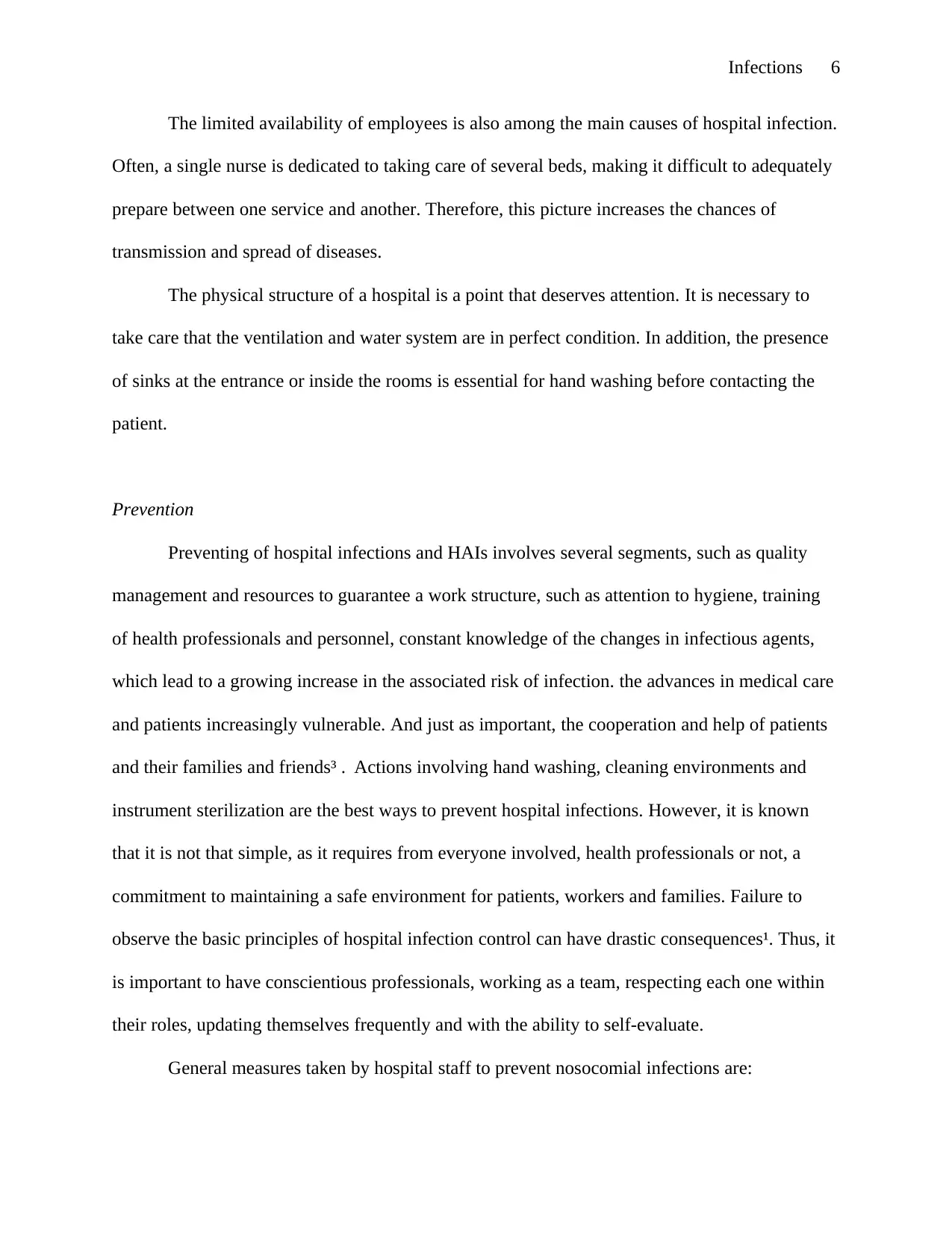
Infections 6
The limited availability of employees is also among the main causes of hospital infection.
Often, a single nurse is dedicated to taking care of several beds, making it difficult to adequately
prepare between one service and another. Therefore, this picture increases the chances of
transmission and spread of diseases.
The physical structure of a hospital is a point that deserves attention. It is necessary to
take care that the ventilation and water system are in perfect condition. In addition, the presence
of sinks at the entrance or inside the rooms is essential for hand washing before contacting the
patient.
Prevention
Preventing of hospital infections and HAIs involves several segments, such as quality
management and resources to guarantee a work structure, such as attention to hygiene, training
of health professionals and personnel, constant knowledge of the changes in infectious agents,
which lead to a growing increase in the associated risk of infection. the advances in medical care
and patients increasingly vulnerable. And just as important, the cooperation and help of patients
and their families and friends³ . Actions involving hand washing, cleaning environments and
instrument sterilization are the best ways to prevent hospital infections. However, it is known
that it is not that simple, as it requires from everyone involved, health professionals or not, a
commitment to maintaining a safe environment for patients, workers and families. Failure to
observe the basic principles of hospital infection control can have drastic consequences¹. Thus, it
is important to have conscientious professionals, working as a team, respecting each one within
their roles, updating themselves frequently and with the ability to self-evaluate.
General measures taken by hospital staff to prevent nosocomial infections are:
The limited availability of employees is also among the main causes of hospital infection.
Often, a single nurse is dedicated to taking care of several beds, making it difficult to adequately
prepare between one service and another. Therefore, this picture increases the chances of
transmission and spread of diseases.
The physical structure of a hospital is a point that deserves attention. It is necessary to
take care that the ventilation and water system are in perfect condition. In addition, the presence
of sinks at the entrance or inside the rooms is essential for hand washing before contacting the
patient.
Prevention
Preventing of hospital infections and HAIs involves several segments, such as quality
management and resources to guarantee a work structure, such as attention to hygiene, training
of health professionals and personnel, constant knowledge of the changes in infectious agents,
which lead to a growing increase in the associated risk of infection. the advances in medical care
and patients increasingly vulnerable. And just as important, the cooperation and help of patients
and their families and friends³ . Actions involving hand washing, cleaning environments and
instrument sterilization are the best ways to prevent hospital infections. However, it is known
that it is not that simple, as it requires from everyone involved, health professionals or not, a
commitment to maintaining a safe environment for patients, workers and families. Failure to
observe the basic principles of hospital infection control can have drastic consequences¹. Thus, it
is important to have conscientious professionals, working as a team, respecting each one within
their roles, updating themselves frequently and with the ability to self-evaluate.
General measures taken by hospital staff to prevent nosocomial infections are:
⊘ This is a preview!⊘
Do you want full access?
Subscribe today to unlock all pages.

Trusted by 1+ million students worldwide
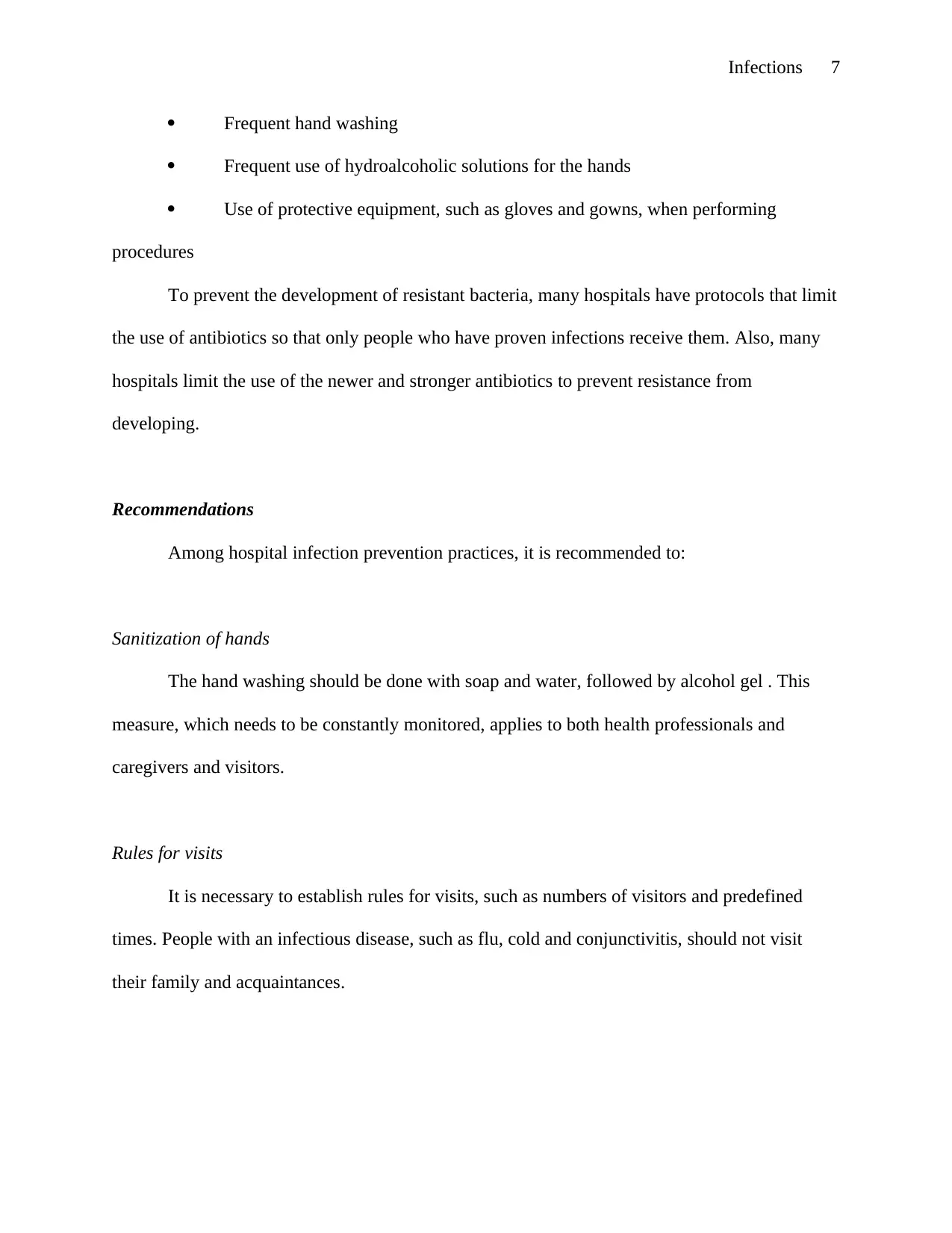
Infections 7
Frequent hand washing
Frequent use of hydroalcoholic solutions for the hands
Use of protective equipment, such as gloves and gowns, when performing
procedures
To prevent the development of resistant bacteria, many hospitals have protocols that limit
the use of antibiotics so that only people who have proven infections receive them. Also, many
hospitals limit the use of the newer and stronger antibiotics to prevent resistance from
developing.
Recommendations
Among hospital infection prevention practices, it is recommended to:
Sanitization of hands
The hand washing should be done with soap and water, followed by alcohol gel . This
measure, which needs to be constantly monitored, applies to both health professionals and
caregivers and visitors.
Rules for visits
It is necessary to establish rules for visits, such as numbers of visitors and predefined
times. People with an infectious disease, such as flu, cold and conjunctivitis, should not visit
their family and acquaintances.
Frequent hand washing
Frequent use of hydroalcoholic solutions for the hands
Use of protective equipment, such as gloves and gowns, when performing
procedures
To prevent the development of resistant bacteria, many hospitals have protocols that limit
the use of antibiotics so that only people who have proven infections receive them. Also, many
hospitals limit the use of the newer and stronger antibiotics to prevent resistance from
developing.
Recommendations
Among hospital infection prevention practices, it is recommended to:
Sanitization of hands
The hand washing should be done with soap and water, followed by alcohol gel . This
measure, which needs to be constantly monitored, applies to both health professionals and
caregivers and visitors.
Rules for visits
It is necessary to establish rules for visits, such as numbers of visitors and predefined
times. People with an infectious disease, such as flu, cold and conjunctivitis, should not visit
their family and acquaintances.
Paraphrase This Document
Need a fresh take? Get an instant paraphrase of this document with our AI Paraphraser
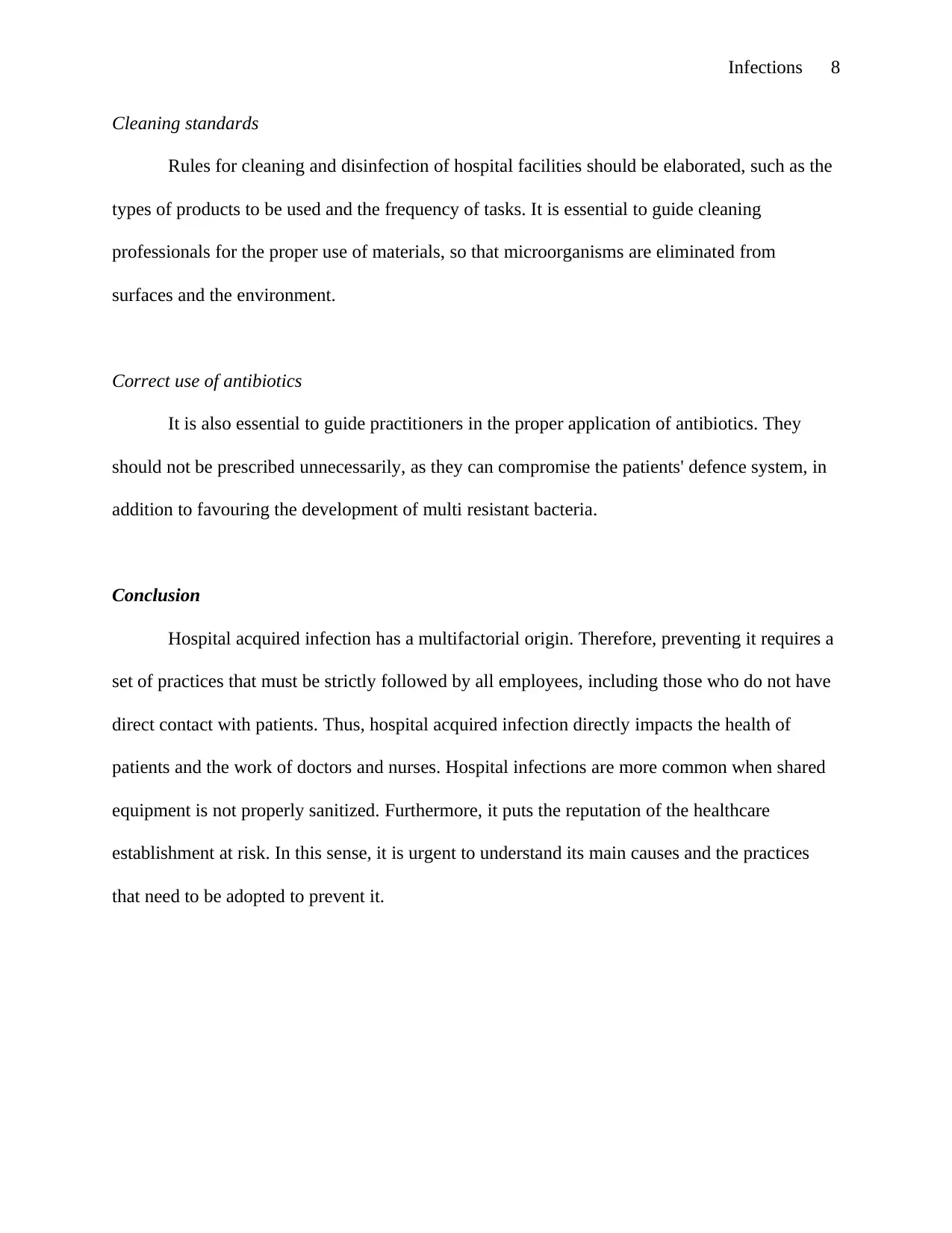
Infections 8
Cleaning standards
Rules for cleaning and disinfection of hospital facilities should be elaborated, such as the
types of products to be used and the frequency of tasks. It is essential to guide cleaning
professionals for the proper use of materials, so that microorganisms are eliminated from
surfaces and the environment.
Correct use of antibiotics
It is also essential to guide practitioners in the proper application of antibiotics. They
should not be prescribed unnecessarily, as they can compromise the patients' defence system, in
addition to favouring the development of multi resistant bacteria.
Conclusion
Hospital acquired infection has a multifactorial origin. Therefore, preventing it requires a
set of practices that must be strictly followed by all employees, including those who do not have
direct contact with patients. Thus, hospital acquired infection directly impacts the health of
patients and the work of doctors and nurses. Hospital infections are more common when shared
equipment is not properly sanitized. Furthermore, it puts the reputation of the healthcare
establishment at risk. In this sense, it is urgent to understand its main causes and the practices
that need to be adopted to prevent it.
Cleaning standards
Rules for cleaning and disinfection of hospital facilities should be elaborated, such as the
types of products to be used and the frequency of tasks. It is essential to guide cleaning
professionals for the proper use of materials, so that microorganisms are eliminated from
surfaces and the environment.
Correct use of antibiotics
It is also essential to guide practitioners in the proper application of antibiotics. They
should not be prescribed unnecessarily, as they can compromise the patients' defence system, in
addition to favouring the development of multi resistant bacteria.
Conclusion
Hospital acquired infection has a multifactorial origin. Therefore, preventing it requires a
set of practices that must be strictly followed by all employees, including those who do not have
direct contact with patients. Thus, hospital acquired infection directly impacts the health of
patients and the work of doctors and nurses. Hospital infections are more common when shared
equipment is not properly sanitized. Furthermore, it puts the reputation of the healthcare
establishment at risk. In this sense, it is urgent to understand its main causes and the practices
that need to be adopted to prevent it.
1 out of 8
Related Documents
Your All-in-One AI-Powered Toolkit for Academic Success.
+13062052269
info@desklib.com
Available 24*7 on WhatsApp / Email
![[object Object]](/_next/static/media/star-bottom.7253800d.svg)
Unlock your academic potential
Copyright © 2020–2025 A2Z Services. All Rights Reserved. Developed and managed by ZUCOL.





